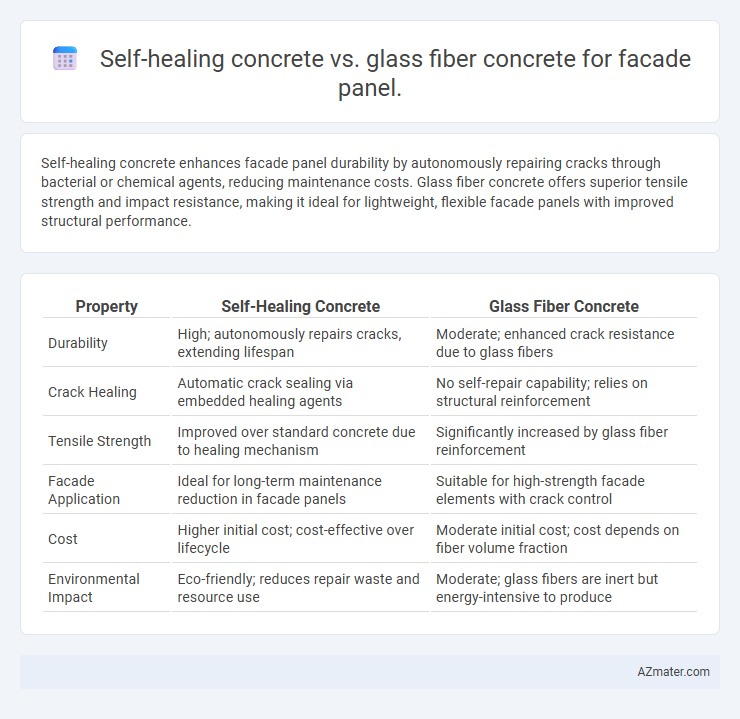Self-healing concrete enhances facade panel durability by autonomously repairing cracks through bacterial or chemical agents, reducing maintenance costs. Glass fiber concrete offers superior tensile strength and impact resistance, making it ideal for lightweight, flexible facade panels with improved structural performance.
Table of Comparison
| Property | Self-Healing Concrete | Glass Fiber Concrete |
|---|---|---|
| Durability | High; autonomously repairs cracks, extending lifespan | Moderate; enhanced crack resistance due to glass fibers |
| Crack Healing | Automatic crack sealing via embedded healing agents | No self-repair capability; relies on structural reinforcement |
| Tensile Strength | Improved over standard concrete due to healing mechanism | Significantly increased by glass fiber reinforcement |
| Facade Application | Ideal for long-term maintenance reduction in facade panels | Suitable for high-strength facade elements with crack control |
| Cost | Higher initial cost; cost-effective over lifecycle | Moderate initial cost; cost depends on fiber volume fraction |
| Environmental Impact | Eco-friendly; reduces repair waste and resource use | Moderate; glass fibers are inert but energy-intensive to produce |
Introduction to Innovative Concrete Facade Materials
Self-healing concrete incorporates microcapsules or bacteria that activate upon cracking, autonomously repairing damage and extending the facade panel's lifespan while reducing maintenance costs. Glass fiber concrete enhances structural integrity with embedded alkali-resistant glass fibers, offering superior tensile strength, durability, and resistance to weathering for facade applications. Both innovative materials address the demand for sustainable, resilient facade solutions, with self-healing concrete prioritizing longevity and crack management and glass fiber concrete emphasizing reinforcement and toughness.
What is Self-Healing Concrete?
Self-healing concrete is an innovative material designed to autonomously repair cracks through embedded healing agents such as bacteria, microcapsules, or polymers that trigger chemical reactions when water or air enters the cracks. This technology enhances durability, reduces maintenance costs, and extends the lifespan of facade panels by preventing water ingress and structural deterioration. In contrast, glass fiber concrete incorporates glass fibers to improve tensile strength and crack resistance but lacks the autonomous repair capability inherent to self-healing concrete.
Properties and Benefits of Glass Fiber Concrete
Glass fiber concrete offers enhanced tensile strength, flexibility, and crack resistance compared to traditional materials, making it ideal for durable facade panels. Its lightweight nature reduces structural load while providing superior weather resistance and long-term durability. This concrete type also supports complex architectural designs due to its moldability and aesthetic versatility.
Durability Comparison: Self-Healing vs Glass Fiber Concrete
Self-healing concrete significantly enhances facade panel durability by autonomously repairing microcracks, reducing water ingress and freeze-thaw damage over time. Glass fiber concrete improves tensile strength and crack resistance but does not possess autonomous crack-sealing capabilities, leading to potential long-term durability issues. Consequently, self-healing concrete offers superior longevity and maintenance reduction compared to glass fiber concrete in facade panel applications.
Flexural and Tensile Strength Performance
Self-healing concrete exhibits enhanced tensile strength due to its ability to autonomously repair micro-cracks, significantly improving durability in facade panels subject to environmental stress. Glass fiber concrete benefits from the high tensile strength of embedded glass fibers, providing superior flexural performance and resistance to cracking under bending loads. Comparative studies indicate self-healing concrete excels in long-term crack mitigation, while glass fiber concrete offers immediate flexural strength advantages for facade applications.
Crack Resistance and Long-Term Maintenance
Self-healing concrete significantly enhances crack resistance in facade panels by autonomously sealing microcracks through embedded healing agents, reducing the need for manual repairs and extending service life. Glass fiber concrete improves crack resistance by distributing stress and preventing crack propagation, but it does not repair existing cracks, leading to higher long-term maintenance costs. Consequently, self-healing concrete offers superior durability and lower maintenance requirements compared to glass fiber concrete for facade applications.
Environmental Impact and Sustainability
Self-healing concrete reduces maintenance frequency and extends the lifespan of facade panels by autonomously repairing micro-cracks, significantly lowering the carbon footprint associated with repairs and replacements compared to traditional materials. Glass fiber concrete offers high durability and resistance to corrosion, which minimizes material usage and waste during production, enhancing sustainability in construction projects. Evaluating environmental impact, self-healing concrete excels in reducing long-term emissions through longevity, while glass fiber concrete contributes by optimizing resource efficiency and structural resilience.
Design Flexibility and Aesthetic Possibilities
Self-healing concrete enhances design flexibility by autonomously repairing micro-cracks, ensuring long-term durability and preserving facade aesthetics without frequent maintenance. Glass fiber concrete offers exceptional aesthetic possibilities through its ability to be molded into intricate shapes and textures while maintaining lightweight strength, enabling innovative facade designs. Both materials improve facade panel resilience, but glass fiber concrete provides greater creative freedom, whereas self-healing concrete prioritizes structural longevity and seamless surface integrity.
Cost Analysis: Initial Investment vs Lifecycle Savings
Self-healing concrete for facade panels requires a higher initial investment, typically 20-30% more than glass fiber concrete, due to specialized materials and curing processes. However, lifecycle savings from reduced maintenance and enhanced durability can lower total costs by up to 25% over 30 years compared to glass fiber concrete, which may require more frequent repairs and replacement. Glass fiber concrete offers lower upfront costs but incurs higher long-term expenses stemming from shorter lifespan and susceptibility to cracking.
Choosing the Right Concrete for Facade Panels
Self-healing concrete offers enhanced durability and longevity for facade panels by automatically repairing micro-cracks, reducing maintenance costs and improving structural integrity over time. Glass fiber concrete provides superior tensile strength and aesthetic flexibility, making it ideal for intricate designs and lightweight facade applications. Selecting the right concrete depends on balancing self-repair capabilities for long-term resilience against the need for design versatility and mechanical strength in the building's exterior facade.

Infographic: Self-healing concrete vs Glass fiber concrete for Facade panel
 azmater.com
azmater.com